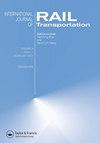Prediction of rail profile evolution on metro curved tracks: wear model and validation
IF 3.6
2区 工程技术
Q2 TRANSPORTATION SCIENCE & TECHNOLOGY
International Journal of Rail Transportation
Pub Date : 2022-08-22
DOI:10.1080/23248378.2022.2113923
引用次数: 3
Abstract
ABSTRACT Rail side wear is typically encountered in metro lines (particularly on sharp curves). A reliable rail wear prediction model to evaluate the evolution of the rail profile should be developed. In this study, a rail wear prediction model for a metro line is established. The vehicle system dynamics model is implemented in the SIMPACK software, which considers the actual operating conditions of the metro line. The results show that using the original Tγ/A wear rate function to calculate rail wear may yield some deviations, which necessitates a modification of the wear model based on the measured results of rail wear. Because the hardness of high and low rails on curved tracks changes after work hardening, different correction coefficients must be adopted for the wear rate function of each rail. The rail wear evolution and worn profiles are consistent with the field measurement results when using a modified wear function.地铁弯曲轨道轨道型线演变预测:磨损模型与验证
本文章由计算机程序翻译,如有差异,请以英文原文为准。
求助全文
约1分钟内获得全文
求助全文
来源期刊

International Journal of Rail Transportation
TRANSPORTATION SCIENCE & TECHNOLOGY-
CiteScore
6.90
自引率
15.00%
发文量
51
期刊介绍:
The unprecedented modernization and expansion of rail transportation system will require substantial new efforts in scientific research for field-deployable technologies. The International Journal of Rail Transportation (IJRT) aims to provide an open forum for scientists, researchers, and engineers in the world to promote the exchange of the latest scientific and technological innovations in rail transportation; and to advance the state-of-the-art engineering and practices for various types of rail based transportation systems. IJRT covers all main areas of rail vehicle, infrastructure, traction power, operation, communication, and environment. The journal publishes original, significant articles on topics in dynamics and mechanics of rail vehicle, track, and bridge system; planning and design, construction, operation, inspection, and maintenance of rail infrastructure; train operation, control, scheduling and management; rail electrification; signalling and communication; and environmental impacts such as vibration and noise. The editorial policy of the new journal will abide by the highest level of standards in research rigor, ethics, and academic freedom. All published articles in IJRT have undergone rigorous peer review, based on initial editor screening and anonymous refereeing by independent experts. There are no page charges and colour figures are included in the online edition free of charge.
 求助内容:
求助内容: 应助结果提醒方式:
应助结果提醒方式:


